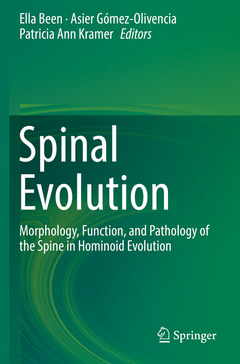Spinal Evolution, 1st ed. 2019 Morphology, Function, and Pathology of the Spine in Hominoid Evolution
Coordonnateurs : Been Ella, Gómez-Olivencia Asier, Ann Kramer Patricia

The vertebral spine is a key element of the human anatomy. Its main role is to protect the spinal cord and the main blood vessels. The axial skeleton, with its muscles and joints, provides stability for the attachment of the head, tail and limbs and, at the same time, enables the mobility required for breathing and for locomotion. Despite its great importance, the vertebral spine is often over looked by researchers because: a) vertebrae are fragile in nature, which makes their fossilization a rare event; b) they are metameric (seriated and repeated elements) that make their anatomical determination and, thus, their subsequent study difficult; and c) the plethora of bones and joints involved in every movement or function of the axial skeleton makes the reconstruction of posture, breathing mechanics and locomotion extremely difficult.
It is well established that the spine has changed dramatically during human evolution. Spinal curvatures, spinal load transmission, and thoracic shape of bipedal humans are derived among hominoids. Yet, there are many debates as to how and when these changes occurred and to their phylogenetic, functional, and pathological implications.
In recent years, renewed interest arose in the axial skeleton. New and exciting finds, mostly from Europe and Africa, as well as new methods for reconstructing the spine, have been introduced to the research community. New methodologies such as Finite Element Analysis, trabecular bone analysis, Geometric Morphometric analysis, and gait analysis have been applied to the spines of primates and humans. These provide a new and refreshing look into the evolution of the spine. Advanced biomechanical research regarding posture, range of motion, stability, and attenuation of the human spine has interesting evolutionary implications. Until now, no book that summarizes the updated research and knowledge regarding spinal evolution in hominoids has been available. The present book explores both these new methodologies and new data, including recent fossil, morphological, biomechanical, and theoretical advances regarding vertebral column evolution. In order to cover all of that data, we divide the book into four parts: 1) the spine of hominoids; 2) the vertebral spine of extinct hominins; 3) ontogeny, biomechanics and pathology of the human spine; and 4) new methodologies of spinal research. These parts complement each other and provide a wide and comprehensive examination of spinal evolution.
Department of Sports Therapy, Faculty of Health Professions, Ono Academic College, Kiryat Ono 55107, Israel
Department of Anatomy and Anthropology, Sackler Faculty of Medicine, Tel Aviv University, Tel Aviv 69978, Israel
E mail: beenella1@gmail.com. Phone: 972-52-3353890
Dept. Estratigrafía y Paleontología, Facultad de Ciencia y Tecnología, Universidad del País Vasco/Euskal Herriko Unibertsitatea (UPV/EHU). Barrio Sarriena s/n, 48940 Leioa, Spain
IKERBASQUE. Basque Foundation for Science.
Centro UCM-ISCIII de Investigación sobre Evolución y Comportamiento Humanos, Avda. Monforte de Lemos 5 (Pabellón 14), 28029 Madrid, Spain.
E mail: asiergo@gmail.com. Phone: +34 627337043 (cell phone) / +34 946012053 (office)
Departments of Anthropology and Orthopaedics & Sports Medicine, University of Washington, Box 353100, Seattle, WA, USA 98195-3100
E mail: pakramer@uw.edu. Phone: 1-206-616-2449 (lab)/ 1-206-650-6407 (cell)
Explores new research methodologies and new data, including recent fossil, morphological, biomechanical, and theoretical advances regarding vertebral column evolution
Details new and exciting finds, mostly from Europe and Africa, as well as new methods for reconstructing the spine
Provides a grounding in the evolutionary history of the human spine from which biomedical research may develop
Date de parution : 08-2020
Ouvrage de 407 p.
15.5x23.5 cm
Disponible chez l'éditeur (délai d'approvisionnement : 15 jours).
Prix indicatif 121,31 €
Ajouter au panierDate de parution : 08-2019
Ouvrage de 407 p.
15.5x23.5 cm
Disponible chez l'éditeur (délai d'approvisionnement : 15 jours).
Prix indicatif 168,79 €
Ajouter au panierThèmes de Spinal Evolution :
Mots-clés :
Vertebral spine; Posture; Locomotion; Hominoids; Pathology; Model vertebrates
